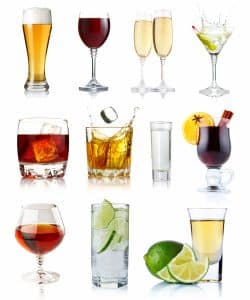How Does Alcohol Use Increase Your Risk for Cancer?


- 12 ounces of beer
- 8–10 ounces of malt liquor
- 5 ounces of wine
- 1.5 ounces, or a “shot,” of 80-proof distilled spirits (liquor)
According to the federal government’s Dietary Guidelines for Americans, 2020–2025, individuals who do not drink alcohol should not start drinking for any reason. The Dietary Guidelines also recommends that people who drink alcohol do so in moderation by limiting consumption to 2 drinks or less in a day for men and 1 drink or less in a day for women. Heavy alcohol drinking is defined as having 4 or more drinks on any day or 8 or more drinks per week for women and 5 or more drinks on any day or 15 or more drinks per week for men.
Ethanol Metabolism: When you consume alcohol (ethanol), your body metabolizes it into acetaldehyde, a toxic substance. Acetaldehyde can damage DNA and proteins, leading to mutations and disruptions in normal cellular functions. This DNA damage can promote the development of cancer.
Oxidative Stress: Alcohol metabolism generates reactive oxygen species (ROS) and other harmful molecules that can cause oxidative stress in cells. Chronic oxidative stress can damage cellular DNA and increase the risk of cancer.
Disruption of DNA Repair: Alcohol consumption can impair the body’s ability to repair DNA damage, which is essential for preventing the accumulation of mutations that can lead to cancer.
Increased Hormone Levels: Alcohol can affect hormone levels in the body, such as estrogen and testosterone. Elevated hormone levels, particularly in the case of breast and prostate cancers, have been linked to an increased cancer risk.
Weakening the Immune System: Excessive alcohol use can weaken the immune system, making it less effective at recognizing and destroying cancer cells before they can develop into tumors.
Increased Risk of Mouth and Throat Cancers: Alcohol is a major risk factor for oral cavity and throat cancers, likely due to direct contact with alcohol in these tissues.
Synergistic Effects with Other Carcinogens: Alcohol can enhance the carcinogenic effects of other substances, such as tobacco smoke. People who both smoke and drink alcohol have a significantly higher risk of developing certain types of cancers, including oral, throat, and esophageal cancers.
Liver Damage: Chronic alcohol consumption can lead to liver cirrhosis and liver cancer (hepatocellular carcinoma). The liver is responsible for metabolizing alcohol, and the prolonged exposure to alcohol and its metabolites can damage liver cells and increase cancer risk.
Gastrointestinal Tract: Alcohol consumption is associated with an increased risk of gastrointestinal cancers, including esophageal, stomach, and colorectal cancers. The mechanisms behind this association are not fully understood but may involve alcohol’s irritant effect on these tissues and its impact on nutrient absorption.
It’s important to note that the risk of cancer increases with the amount and duration of alcohol consumption. Even moderate alcohol consumption has been linked to an increased cancer risk in some studies. Therefore, reducing or eliminating alcohol consumption can be an effective way to lower your risk of developing alcohol-related cancers. If you have concerns about alcohol and cancer risk, it’s advisable to consult with a healthcare professional for personalized guidance and recommendations.
Lorem ipsum dolor sit amet, consectetur adipiscing elit. Ut elit tellus, luctus nec ullamcorper mattis, pulvinar dapibus leo.
